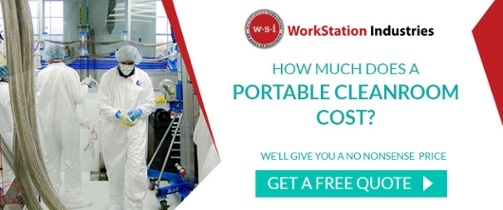The equipment in a modular clean room plays a critical role in whether the room operates as it is designed to do.
Modular clean rooms, otherwise known as portable clean rooms, are an excellent choice for many businesses because they offer more flexibility and the ability to be altered versus permanent clean rooms.
Although you may have properly assessed your application’s needs and have determined that a portable clean room is right for your business, ensuring it is up and running properly involves more than the structure itself.
Here are some considerations to keep in mind when placing equipment in your clean room and maintaining that equipment so that the space can operate as efficiently and safely as possible.
Modular Clean Room Equipment Placement
 One of the most important items to consider when placing lab equipment and furniture in a modular clean room is the flow of materials and people.
One of the most important items to consider when placing lab equipment and furniture in a modular clean room is the flow of materials and people.
That’s because workers inside the clean room are one of the biggest risks for contamination. A room’s layout can also have an impact on productivity. Therefore, all pieces of furniture and equipment associated with critical processes should be placed away from high traffic areas, doors and other areas that could interfere with these processes.
One of the most common pieces of equipment in a clean room is a fume hood. Fume hoods are commonly found in industrial and manufacturing settings, from laboratories to medical facilities and plants.
It is critical to minimize air disturbances when operating a fume hood to avoid limiting the equipment’s effectiveness. That’s why the placement of the fume hood - and contents inside and around - are so important.
When installing a fume hood, take note of the following in order to eliminate the possibility of crosscurrents:
- Pedestrian traffic and high-traffic areas
- Where doors are located and how often they open and close
- Where windows are located
- Whether there are any exterior fans and supply air diffusers
In the case of equipment placement around a fume hood:
- Place blocks under large equipment inside the hood to allow air to flow beneath it.
- Keep containers or equipment six inches or more from the face of the hood.
- Avoid storing or keeping nearby paper products, chemical wipes and aluminum foil, since lightweight materials such as these can easily get sucked into the exhaust.
- Do not store chemicals or lab equipment in the hood if possible.
With any piece of laboratory equipment, follow the manufacturer’s guidelines regarding the placement of this equipment in a clean room.
Modular Clean Room Equipment Materials
Depending on your workspace functions, you may need workbenches, casework, chairs, cabinets and other pieces of equipment for your modular clean room.
Based on your application, you may need some or all of these pieces of equipment and furniture to be constructed using certain materials.
Static electricity can be a big issue in many clean rooms, which is why many of Electro Static Dissipative (ESD) requirements put into place. These requirements extend to the equipment and materials used inside the clean room.
If not addressed, static electricity can impact precision weighing and cause safety hazards. Examples of items you may use inside a clean room in which static electricity is a concern include ESD chairs and ESD laminate surfaces.
When choosing materials for your workstations inside a modular clean room, you’ll also want to consider the material’s resistance to substances you work with and environmental factors such as heat and moisture.
Some of the most common materials used in a laboratory setting include:
- Phenolic resin, which is highly resistant to bacteria, chemicals, fungus and moisture
- Epoxy resin, which is also highly resistant to the above along with corrosion
- Stainless steel, which is highly resistant to bacteria, fungus, water and moisture
- Chemical resistant laminate, which is highly resistant to chemicals
- High pressure laminate, which is the most economical choice
You can learn more about the pros and cons of each of these in our article, Types Of Industrial Workbench Tops.
Additional Considerations
There are a few other considerations you should keep in mind regarding your clean room equipment.
Know your ISO classification: Your ISO classification plays an important role in determining your cleanliness requirements. Keep in mind, your ISO classification can change over time as you take on new projects. This classification can impact the type of equipment you use inside the clean room.
Maintain regular cleanings: Each piece of equipment inside your clean room likely requires a specific method of cleaning - not only to preserve the equipment but also to maintain cleanliness standards inside the room. Cleanings are much more involved than a cleaner and rag as well. The tools used to clean a space, like vacuums and sponges, can be a source of contamination, and specialized solvents for clean rooms should be used.
Keep staff fully trained: Clean room equipment maintenance should be a priority to everyone. Staff should also know how to prepare for entry into and exit out of the clean room, as well as proper attire to wear.
Modular clean rooms are a great economical choice for many businesses because of their flexibility and ability to be altered with growth or movement. However, the equipment inside the clean room goes hand-in-hand with the clean room itself. Proper placement, materials and maintenance are critical to ensuring your goals as a lab are met.


